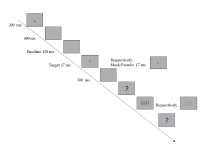Electroencephalogram (EEG) protocol for to disentangle neural correlates of phenomenal from access consciousness vision.
From healthy persons to smart devices, through brain–computer interfaces (BCIs) to people in vegetative states and intraneural interfaces implants on human amputees, the EEG technique promise a popular and cheap avenue of new tools to improve human life. In particular, in the case of our experimental protocol people with varying degrees of vision from almost none to normal vision through the amblyopia.
Our goal is to design two EEG experiments and analyze the related behavioral data in order to obtain empirical evidence that visual phenomenal consciousness is distinct from visual access consciousness : distinct neuroelectric signals. Access, we hope to show, is not constitutive of phenomenal consciousness: mental states can be phenomenologically independent of its relations with the rest of the cognitive system.
Apparatus and stimuli
Two types of targets: square (1.98 cm side) or diamond (for 45 ° rotation of the square).
Two types of masks: mask or pseudo-mask.
The width of the mask is 3.05 cm and its inner white portion (RGB 255-255-255) is 8 mm wider than the black (RGB 0-0-0) target stimulus.
The width of the pseudo-mask is 3.10 cm and its inner white portion is circular (2.63 cm diameter).
Despite the different sizes, the color black stands in the same area, both in mask and pseudo-mask, and its luminance is identical. This was expected to be important to make the masks produce similar ERPs when presented alone.
All stimuli are presented on a gray background (RGB 173-175-178).
Procedure
First task: to recognize which of the targets – square or diamond – is presented.
Second task: to evaluate the visibility of targets.
The answers are givens using the keyboard or the mouse.
In the first task, recognition of targets, participants respond if "they seemed to have seen something" by pressing "8" to "yes” and "9" to "no". A negative response completes the trial and starts the next. An affirmative answer conduces the subjects to a screen of sixteen stimuli to signal with the mouse what seems they have been identified. The position on the screen indicated by the participant will be recorded informatically as coordinate system .
In the second task (evaluation of visibility) we used a Likert scale from "1" to "5": "not visible at all" ("1" key), "barely visible" ("2" key), "visible, but obscure" (key" 3 "), "clear but not quite visible" (key "4 ") and "perfectly clear and visible" ("5" key).
It is expected that the running of experiment train the volunteer. The beginning of the behavioral and EEG recording is unknown to the volunteer.
Like this entry?
-
About the Entrant
- Name:Vitor Pereira
- Type of entry:individual
- Patent status:none








